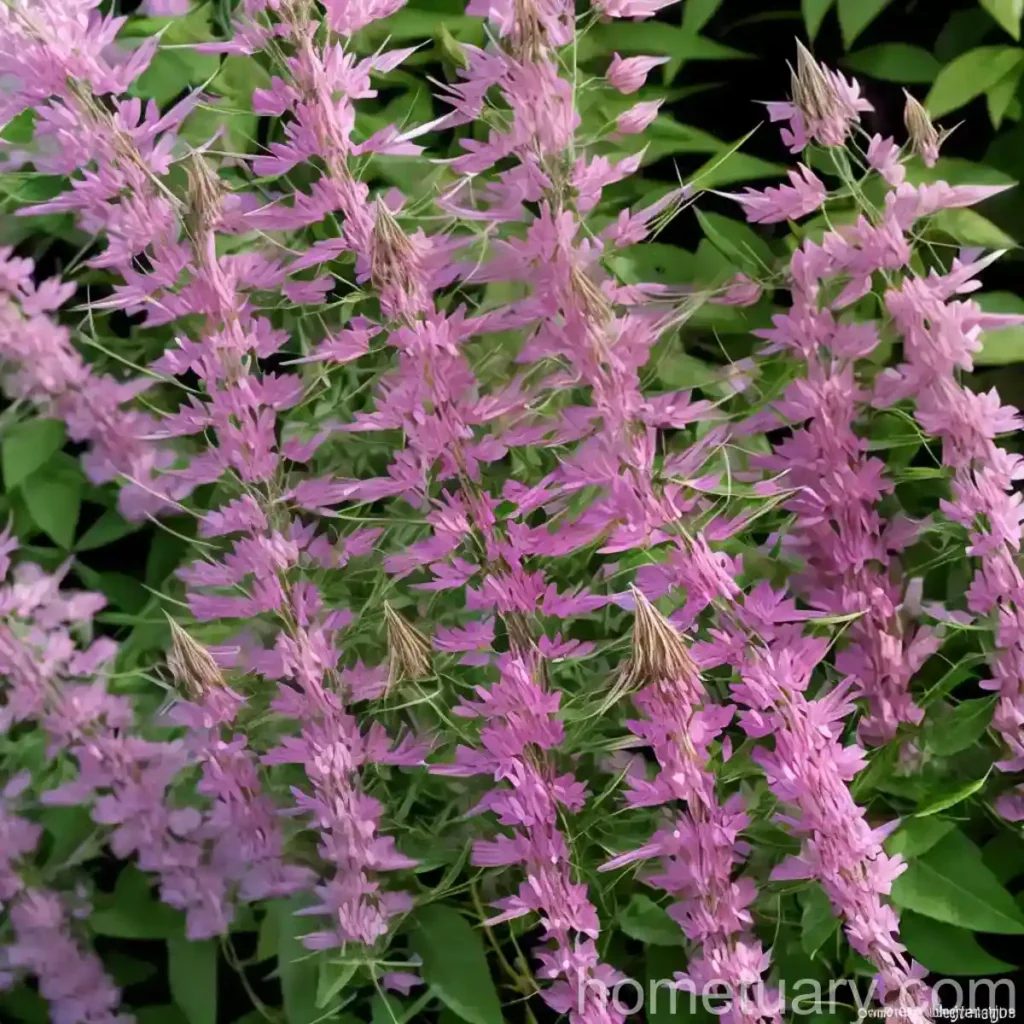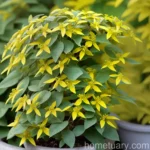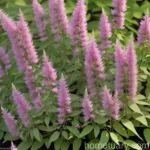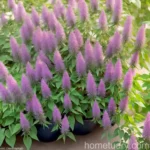All About Bush Clover (Lespedeza thunbergii ‘Pink Cascade’)
Bush clover, scientifically known as Lespedeza thunbergii ‘Pink Cascade’, is a delightful ornamental flowering shrub that has gained popularity in gardens and landscaping for its elegant pink cascading flowers. This beautiful perennial plant is not only visually appealing but also offers various benefits, including drought tolerance and low maintenance. In this comprehensive guide, we will delve into the various aspects of bush clover, including its culture, uses, care requirements, common diseases and pests, propagation, and much more. Whether you’re an experienced gardener or just starting, this guide will provide valuable insights into the world of Lespedeza thunbergii ‘Pink Cascade’ and help you cultivate a thriving and vibrant garden landscape.
What is Bush Clover (Lespedeza thunbergii ‘Pink Cascade’)?
Bush clover, also known by its scientific name Lespedeza thunbergii ‘Pink Cascade’, is a perennial flowering plant that belongs to the Fabaceae family. Originating from East Asia, particularly Japan, this plant is cultivated for its attractive appearance and stunning display of cascading pink flowers, making it a popular choice for garden landscaping and ornamental purposes.
Lespedeza thunbergii ‘Pink Cascade’ is characterized by its arching, cascading branches adorned with an abundance of delicate, pink pea-like flowers that bloom from late summer to early fall, adding a touch of elegance and color to outdoor spaces. With its graceful weeping growth habit and prolific blooming, this shrub serves as a captivating focal point in gardens and landscapes.
Key Takeaways – Bush Clover (Lespedeza thunbergii ‘Pink Cascade’)
Before we dive into the specific aspects of bush clover, let’s summarize some key takeaways about Lespedeza thunbergii ‘Pink Cascade’:
- Plant Name: Lespedeza thunbergii ‘Pink Cascade’
- Common Names: Bush clover, Pink Cascade bush clover
- Plant Type: Perennial flowering shrub
- Flower Color: Pink
- Sunlight Requirements: Full sun to partial shade
- Watering Needs: Moderately moist, well-drained soil
- Hardiness Zone: USDA Zones 4-9
- Special Features: Drought-tolerant, low-maintenance, ornamental
- Uses: Garden landscaping, ornamental display
Now, let’s explore the various aspects of bush clover in detail, from its culture and care requirements to its propagation and common pests and diseases.
Culture
Cultivating bush clover successfully involves understanding its specific cultural requirements, including its preferences for water, sunlight, soil, and fertilizer. By providing the ideal growing conditions, you can ensure that your Lespedeza thunbergii ‘Pink Cascade’ thrives and flourishes in your garden or landscape.
Uses
Bush clover, with its graceful cascading branches and profusion of pink flowers, serves several practical and aesthetic purposes in outdoor settings. Understanding its uses can help you integrate it effectively into your garden or landscape design.
-
Ornamental Display: The stunning display of pink cascading flowers makes bush clover an ideal choice for ornamental purposes. Its graceful weeping growth habit adds a touch of elegance to garden landscapes.
-
Garden Landscaping: Bush clover can be used to enhance the visual appeal of garden beds, borders, and various landscape settings. Its vibrant pink flowers can complement the overall aesthetic of the outdoor space.
Water
Establishing an appropriate watering regimen is crucial for ensuring the health and vitality of bush clover. While this plant exhibits some level of drought tolerance, consistent moisture is essential, especially during the establishment phase and periods of prolonged heat or dryness.
-
Watering Frequency: Bush clover generally requires regular watering, especially during dry spells or extended periods of heat. Ensure that the soil remains moderately moist but well-drained. Avoid overwatering, which can lead to waterlogged soil and potentially harm the plant.
-
Monitoring Soil Moisture: Regularly monitor the soil moisture levels, particularly during hot weather. Adjust the watering frequency based on the specific environmental conditions and the moisture needs of the plant.
Sunlight
Understanding bush clover’s sunlight requirements is essential for ensuring optimal growth and flowering. Adequate exposure to sunlight is crucial for promoting healthy foliage and prolific blooming.
-
Sunlight Preferences: Lespedeza thunbergii ‘Pink Cascade’ thrives in full sun to partial shade. Ensure that the plant receives at least 6-8 hours of direct sunlight per day for the best flowering performance.
-
Shade Considerations: While bush clover prefers full sun, it can tolerate partial shade, especially in warmer climates or during the intense midday sun. However, reduced sunlight exposure may impact its flowering potential and overall vigor.
Fertilizer
Applying the right type of fertilizer at the appropriate times can contribute significantly to the growth, flowering, and overall health of bush clover. Understanding the fertilization needs of the plant is essential for providing essential nutrients and promoting robust growth.
-
Fertilizer Type: Use a balanced, slow-release fertilizer formulated for flowering shrubs. Look for a fertilizer with a higher phosphorus content to support prolific flowering.
-
Application Timing: Apply the fertilizer in early spring, just before the growing season begins. Avoid excessive fertilization, as it can lead to excessive foliage growth at the expense of flowering.
Soil
The soil composition and quality directly impact the overall health and performance of bush clover. Providing well-drained, nutrient-rich soil is essential for supporting the plant’s root development and overall vigor.
-
Soil Type: Bush clover thrives in well-drained, loamy soil with a slightly acidic to neutral pH. Ensure that the soil has good aeration and is free from compaction to facilitate healthy root growth.
-
Amending Soil: If your soil is heavy or compacted, consider amending it with organic matter, such as compost or well-rotted manure, to improve its texture and drainage.
Pruning
Pruning plays a crucial role in maintaining the desired shape, size, and overall appearance of bush clover. Understanding the appropriate pruning techniques and timing is essential for promoting healthy growth and enhancing the plant’s visual appeal.
-
Pruning Timing: Perform major pruning tasks, such as shaping and size control, in late winter or early spring before the onset of new growth. Light pruning to remove spent flowers can be done throughout the blooming season to encourage continuous flowering.
-
Pruning Techniques: Use sharp, clean pruning tools to make precise cuts. Aim to maintain the natural arching form of the plant while removing any dead, damaged, or overgrown branches.
Propagation
Propagating bush clover allows you to expand your plant collection or share this beautiful ornamental shrub with others. Understanding the propagation methods and best practices is essential for successfully propagating Lespedeza thunbergii ‘Pink Cascade’.
-
Propagation Methods: Bush clover can be propagated from seeds, softwood cuttings, or division. Each method has its specific requirements and ideal timing for success.
-
Seed Propagation: Collect mature seeds from the plant and sow them in well-prepared seed-starting mix. Keep the soil consistently moist and provide warmth for germination to occur.
-
Cutting Propagation: Take softwood cuttings in late spring to early summer, ensuring that each cutting has at least one leaf node. Root the cuttings in a well-draining rooting medium under controlled conditions.
-
Division: Splitting established clumps of bush clover is a viable method for propagation. Divide the plant in early spring before new growth emerges, ensuring that each division has healthy roots and shoots.
Container Popularity
Bush clover’s aesthetic appeal, low-maintenance nature, and versatility make it an excellent candidate for container gardening. Whether you have limited outdoor space or want to add a decorative touch to patios and balconies, growing Lespedeza thunbergii ‘Pink Cascade’ in containers can be a rewarding experience.
-
Container Selection: Choose a large, sturdy container with adequate drainage holes to accommodate the plant’s growth and prevent waterlogging. Consider the visual aesthetics and overall design when selecting a container.
-
Soil and Watering: Use a well-draining potting mix to ensure proper moisture management. Monitor the soil moisture regularly and water as needed to maintain consistent moisture levels.
-
Sunlight Requirements: Position the container in a location that receives ample sunlight, as bush clover thrives in full sun to partial shade. Rotate the container periodically to promote even growth.
Common Diseases
While bush clover is generally resilient, it can be susceptible to certain diseases under unfavorable growing conditions. Identifying and addressing common diseases promptly is crucial for maintaining the health and vigor of the plant.
-
Powdery Mildew: This fungal disease can manifest as a powdery white coating on the foliage, impacting the plant’s overall health. Provide good air circulation and avoid overhead watering to reduce the risk of powdery mildew.
-
Root Rot: Overly wet or poorly drained soil can predispose bush clover to root rot, causing wilting, yellowing foliage, and stunted growth. Ensure that the soil has adequate drainage, and avoid overwatering.
-
Leaf Spot: Lespedeza thunbergii ‘Pink Cascade’ may experience leaf spot diseases, characterized by the development of dark spots on the foliage. Maintain good sanitation practices and consider fungicidal treatments if necessary.
Disease Diagnosis
Diagnosing and addressing potential diseases in bush clover involves careful observation of the plant’s symptoms and implementing appropriate management strategies. Understanding the signs of common diseases can help you proactively protect your plant from potential threats.
-
Symptom Identification: Look for visual cues, such as unusual discoloration, spots, or abnormal growth patterns on the foliage, stems, or flowers. Assess the overall vigor and appearance of the plant for signs of distress.
-
Consulting Experts: If you suspect disease or are uncertain about the symptoms, seek guidance from local gardening experts, plant pathologists, or extension services to obtain accurate diagnosis and treatment recommendations.
Common Pests
Although bush clover is relatively resistant to pests, it may encounter occasional pest infestations that warrant attention. Identifying and addressing common pests promptly can help minimize damage and protect the plant’s health.
-
Aphids: These small, sap-sucking insects can cluster on the tender new growth of bush clover, causing distortion and yellowing of the leaves. Use a strong water spray or insecticidal soap to control aphid populations.
-
Spider Mites: Spider mites may infest bush clover, especially in hot and dry conditions, leading to stippled, discolored foliage. Increase humidity around the plant and consider using predatory mites as a biological control measure.
-
Caterpillars: Certain caterpillar species may feed on the foliage of bush clover, causing visible defoliation. Handpick caterpillars when feasible or use biological insecticides to manage infestations.
Botanist’s Tips
As a plant scientist with expertise in ornamental plants, I would like to share some valuable tips for successfully growing and caring for bush clover (Lespedeza thunbergii ‘Pink Cascade’). These insights are based on scientific knowledge and practical experience and can help enthusiasts and gardeners achieve optimal results with this beautiful flowering shrub.
Tip 1: Selecting the Ideal Planting Location
When choosing a location for planting bush clover, consider the specific sunlight and soil requirements of the plant. Select a site that receives ample sunlight and provides well-drained soil with good air circulation. Avoid areas prone to waterlogging or excessive shade, as these conditions can affect the plant’s performance.
Tip 2: Implementing Regular Maintenance
Engage in routine maintenance practices, such as watering, mulching, and fertilizing, to support the health and vitality of bush clover. Regular monitoring of the plant’s growth, flowering, and overall condition allows for timely interventions and adjustments, promoting long-term success.
Tip 3: Embracing Diversity in Garden Design
Integrate bush clover into diverse garden designs and landscaping settings to enhance visual interest and create dynamic outdoor spaces. Utilize its cascading form and vibrant pink flowers to complement other plantings, such as ornamental grasses, perennials, and flowering shrubs, for a harmonious and captivating display.
Tip 4: Promoting Wildlife Habitat
As an ornamental shrub with attractive flowers, bush clover can contribute to supporting local wildlife, including bees, butterflies, and other pollinators. Embrace its role in wildlife habitat enhancement and consider its ecological value when planning and incorporating it into garden landscapes.
Tip 5: Monitoring and Adjusting Care Practices
Regularly monitor the response of bush clover to its growing conditions and care regimen. Adjust watering, fertilization, and pruning practices based on the plant’s performance and seasonal variations to optimize its health and flowering potential.
Fun Facts
Uncover fascinating and intriguing facts about bush clover (Lespedeza thunbergii ‘Pink Cascade’) that highlight its unique characteristics and enrich your appreciation for this captivating ornamental shrub.
-
Cultural Significance: In Japan, Lespedeza thunbergii holds cultural significance and is celebrated for its beauty. It is often associated with the autumn season and is featured in traditional art and poetry.
-
Wildlife Attraction: The vibrant pink flowers of bush clover attract various pollinators, including bees and butterflies, contributing to biodiversity in outdoor spaces.
-
Historical Roots: The genus Lespedeza is named after the Spanish governor of Florida, Vicente Manuel de Céspedes, who promoted the cultivation of forage plants, including species within the genus.
-
Erosion Control: Certain species of Lespedeza have been utilized for erosion control and soil stabilization due to their extensive root systems and adaptability to diverse environmental conditions.
Links to External Resources
Explore additional resources and information about bush clover, gardening, and ornamental plants to broaden your knowledge and enhance your experience as a plant enthusiast or gardener.
-
American Horticultural Society – Access valuable gardening resources, plant profiles, and educational materials through the American Horticultural Society.
-
Royal Horticultural Society – Discover expert gardening advice, plant care guidelines, and horticultural insights from the Royal Horticultural Society.
-
University Extension Services – Utilize the extension services offered by various universities for comprehensive gardening information, including plant selection, care, and pest management.
-
Botanical Gardens and Arboreta – Visit botanical gardens and arboreta to gain inspiration and learn about diverse plant collections, including ornamental shrubs and flowering perennials.
-
Online Gardening Forums and Communities – Engage with fellow gardeners and plant enthusiasts in online gardening forums and communities to exchange knowledge, seek advice, and share experiences about growing bush clover and other ornamental plants.
By leveraging these external resources, you can expand your understanding of bush clover, access expert advice, and connect with a community of like-minded individuals passionate about gardening and horticulture.
In conclusion, bush clover (Lespedeza thunbergii ‘Pink Cascade’) stands as a captivating and versatile ornamental shrub, offering an array of aesthetic, ecological, and cultural benefits. By embracing its unique characteristics and understanding its specific cultural needs, enthusiasts and gardeners can cultivate thriving landscapes and enhance outdoor spaces with the enchanting beauty of this perennial plant. Whether adorning garden beds, borders, or container gardens, the graceful presence and vibrant pink flowers of bush clover enrich the horticultural experience and contribute to the visual tapestry of natural landscapes.
As a plant scientist, I encourage you to explore the world of Lespedeza thunbergii ‘Pink Cascade’ and embark on an enriching journey of discovery, cultivation, and appreciation for this remarkable flowering shrub.
Note: The above content provides an in-depth exploration of bush clover (Lespedeza thunbergii ‘Pink Cascade’) covering various aspects such as culture, uses, care requirements, propagation, common diseases, pests, and botanist’s tips. It also includes fun facts and links to external resources to further enrich the reader’s knowledge.















